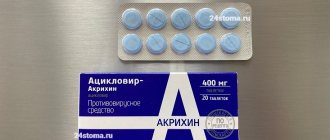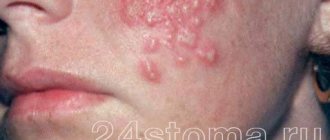Valaciclovir Canon tablets 500 mg 10 pcs.
The drug Valacyclovir Canon should be taken regardless of meals, the tablets should be washed down with water. Treatment of herpes zoster. Adults. Valaciclovir is prescribed at a dose of 1 g 3 times a day for 7 days. Treatment of infections caused by HSV. Adults. Valacyclovir is prescribed at a dose of 500 mg 2 times a day. In case of relapse, treatment should continue for 3 or 5 days. In more severe primary cases, treatment should be started as early as possible, and its duration should be increased from 5 to 10 days. For recurrent HSV, it is ideal to prescribe valacyclovir in the prodromal period or immediately after the first symptoms of the disease appear. As an alternative for the treatment of herpes labialis (labial fever), the administration of valacyclovir at a dose of 2 g twice daily is effective. The second dose should be taken approximately 12 hours (but not earlier than 6 hours) after the first dose. When using this dosing regimen, the duration of treatment should not exceed 1 day as this has not been shown to provide additional clinical benefit. Thearpia should be started when the earliest symptoms of labial fever (ie, tingling, itching, burning) appear. Prevention (suppression) of recurrent infections caused by HSV. Adults. In patients with preserved immunity, valacyclovir is prescribed at a dose of 500 mg once daily. In patients with very frequent relapses (10 or more per year), an additional effect can be achieved by prescribing valacyclovir at a daily dose of 500 mg, divided into 2 doses (250 mg 2 times a day). For adult patients with immunodeficiencies, the recommended dose of valacyclovir is 500 mg 2 times a day. Duration of treatment is 4-12 months. Prevention of infection with genital herpes in a healthy partner. Infected heterosexual adults with preserved immunity and with the number of exacerbations up to 9 per year, valacyclovir should be taken 500 mg 1 time per day for a year or more, every day with regular sexual activity, with irregular sexual intercourse, valacyclovir should be taken 3 days before suspected sexual contact. There are no data on prophylaxis in other patient populations. Prevention of CMV infection after transplantation. Doses for adults and adolescents (from 12 years of age). It is recommended to prescribe valacyclovir at a dose of 2 g 4 times daily as soon as possible after transplantation. The dose should be reduced depending on creatinine clearance. The duration of treatment is 90 days, but in high-risk patients, treatment may be longer.
Compound
| Film-coated tablets | 1 table |
| active substance: | |
| valacyclovir hydrochloride monohydrate | 583.8 mg (573–591 mg) |
| (in terms of valacyclovir hydrochloride - 556 mg; valacyclovir - 500 mg) | |
| excipients: MCC - from 37 to 55 mg; crospovidone - 15 mg; povidone - 50 mg; magnesium stearate – 7 mg | |
| film shell: Opadry white YS-1-7003 (titanium dioxide - 31.25%; hypromellose (3cP, 6cP) - 29.875%; macrogol (polyethylene glycol 400) - 8%; polysorbate (Tween 80) - 1%) - 17, 5 mg |
Side effects
According to the frequency of occurrence, side effects are divided into the following categories: very often (≥10%); often (≥1% and <10%); uncommon (≥0.1% and <1%); rare (≥0.01% and <0.1%); very rare (<0.01%).
From the side of the central nervous system: often - headache; rarely - dizziness, confusion, hallucinations, impaired mental abilities; very rarely - agitation, tremor, ataxia, dysarthria, psychotic symptoms, convulsions, encephalopathy, coma. These symptoms are reversible and are usually observed in patients with impaired renal function or against the background of other predisposing conditions.
From the respiratory system: infrequently - shortness of breath.
From the digestive system: often - nausea; rarely - abdominal discomfort, vomiting, diarrhea; very rarely - reversible disorders of functional liver tests, which are sometimes regarded as manifestations of hepatitis.
From the skin and subcutaneous tissues: infrequently - skin rash, photosensitivity; rarely - itching.
Allergic reactions: very rarely - urticaria, angioedema, anaphylactic reactions.
From the urinary system: rarely - renal dysfunction; very rarely - acute renal failure, renal colic. Renal colic may be associated with impaired renal function.
From the hematopoietic organs: very rarely - leukopenia, thrombocytopenia.
Other: In patients with severe immune impairment, especially in adult patients in the late stages of acquired immune deficiency syndrome (AIDS), receiving valacyclovir in high doses (8 g / day daily) for a long time, cases of renal failure, microangiopathic hemolytic anemia and thrombocytopenia (sometimes in combination). Similar complications have been noted in patients with the same diseases but not receiving valacyclovir.
Contraindications
hypersensitivity to valacyclovir, acyclovir, as well as other components included in the drug;
HIV infection with a CD4+ lymphocyte count of less than 100/μl;
children's age (up to 12 years - for the prevention of cytomegalovirus infection during organ transplantation; up to 18 years - for other indications).
With caution: liver/renal failure; clinically expressed forms of HIV infection; pregnancy; lactation period; elderly age; hypohydration; concomitant use of nephrotoxic drugs.
Pharmacokinetics
After oral administration, it is well absorbed from the gastrointestinal tract. With the participation of the liver enzyme valacyclovir hydrolase, it is quickly and almost completely converted into acyclovir and L-valine. Bioavailability (in terms of acyclovir) when taken at a dose of 1000 mg is 54% and does not depend on food intake. After using valacyclovir at a dose of 1 g 4 times a day, the AUC is approximately equal to the AUC with intravenous administration of acyclovir at a dose of 5 mg every 8 hours. Cmax after a single dose of 1 g is 15–25 µmol/ml, time to reach Cmax is 1.6 –2.1 h; after 3 hours, unmetabolized valacyclovir is not detected in plasma. Plasma protein binding of valacyclovir is 13–18%, acyclovir is 9–33%.
Acyclovir is widely distributed in tissues and body fluids, including the brain, liver, uterus, mucous membrane and vaginal secretions, semen, cerebrospinal fluid (50% of the concentration in plasma), fluid of herpetic vesicles. Penetrates through the placenta and into breast milk.
The metabolism of valacyclovir/acyclovir is not associated with cytochrome P450 enzymes.
After repeated use of valacyclovir in patients with normal renal function, acyclovir does not accumulate. T1/2 of valacyclovir in patients with normal renal function - less than 30 minutes; acyclovir - 2.5-3.3 hours, in end-stage chronic renal failure (CRF) - 14 hours, in elderly patients (65-83 years old) - 3.3-3.7 hours.
Excreted by the kidneys (45.6%), mainly in the form of acyclovir (more than 80% of the dose) and its metabolite 9-carboxymethoxymethylguanine, less than 1% - unchanged and through the intestines (47.12%) within 96 hours. In patients, those on hemodialysis, T1/2 - about 4 hours; During the 4-hour procedure, about 30% of the drug is removed. With peritoneal dialysis, the drug is removed to a lesser extent.
Use during pregnancy and breastfeeding
There are limited data on the use of valacyclovir during pregnancy. Valaciclovir is used only in cases where the potential benefit to the mother outweighs the possible risk to the fetus. Reported data on pregnancy outcomes in women taking valacyclovir or acyclovir did not show an increase in the number of birth defects in their children compared with the general population. Since the registry included a small number of women who took valacyclovir during pregnancy, reliable and definite conclusions about the safety of valacyclovir during pregnancy cannot be made.
Acyclovir, the main metabolite of valacyclovir, is excreted in breast milk. When the mother takes valacyclovir orally at a dose of 500 mg 2 times a day, the child will be exposed to the same effects of acyclovir as when it is taken orally at a dose of about 0.61 mg/kg/day. T1/2 of acyclovir from breast milk is the same as from blood plasma. Valaciclovir unchanged was not detected in maternal plasma, breast milk or infant urine. Valacyclovir should be administered with caution to nursing women. However, intravenous acyclovir at a dose of 30 mg/kg/day is used in newborns to treat diseases caused by HSV.
Interaction
Cimetidine and probenecid (tubular secretion blockers) increase the AUC of acyclovir and reduce its renal clearance. In individuals with normal creatinine clearance, dosage regimen adjustment is not required, because acyclovir has a wide therapeutic index.
Nephrotoxic drugs (including cyclosporine, tacrolimus) increase the risk of developing renal dysfunction.
Acyclovir is excreted from the body in the urine mainly unchanged through active tubular secretion. When taking valacyclovir concomitantly with drugs that compete for this elimination mechanism, it is possible to increase the level of acyclovir or both drugs (or their metabolites). An increase in the AUC of acyclovir and the inactive metabolite mycophenolate mofetil was observed when these drugs were used concomitantly.
The pharmacokinetics of valacyclovir does not change when taken concomitantly with digoxin, aluminum-/magnesium-containing antacids, and thiazide diuretics.
Indications for the drug Valacyclovir
Adults:
treatment of herpes zoster (herpes zoster);
treatment of skin and mucous membrane infections caused by herpes simplex virus types 1 and 2 (including newly diagnosed genital herpes, recurrent genital herpes (Herpes genitalis) and labial herpes (Herpes labialis);
prevention (suppression) of recurrent infections of the skin and mucous membranes caused by herpes simplex virus types 1 and 2 (including genital herpes);
reducing the risk of transmitting genital herpes to a healthy partner.
Adults and teenagers 12 years and older:
prevention of cytomegalovirus infection occurring during organ transplantation.
Pharmacodynamics
Antiviral drug. Specific nucleoside inhibitor of DNA polymerase of herpes viruses. In the human body it is quickly converted into acyclovir and L-valine; As a result of phosphorylation, active acyclovir triphosphate is formed from acyclovir, which competitively inhibits the viral DNA polymerase and, being an analogue of purine nucleoside (guanine), is integrated into the viral DNA, which leads to a complete break of the chain, cessation of DNA synthesis and blocking of viral replication. The first stage of phosphorylation occurs under the influence of a virus-specific enzyme (for Herpes simplex viruses types 1 and 2, Varicella zoster is a viral thymidine kinase, which is found only in cells infected with the virus). For CMV, the selectivity of the drug is due to the fact that phosphorylation is partially mediated by the product of the UL97 phosphotransferase gene. The drug is active in vitro against herpes simplex viruses (HSV) types 1 and 2, herpes zoster virus, Epstein-Barr virus, CMV and human herpes virus type 6.
In patients with preserved immunity, Herpes simplex and Varicella zoster viruses with reduced sensitivity to valacyclovir are extremely rare (less than 0.1%), but can sometimes be detected in patients with severe immune disorders, for example with a bone marrow transplant, in those receiving chemotherapy for malignant neoplasms and HIV-infected people.
special instructions
In patients at risk of dehydration, especially elderly patients, it is necessary to maintain adequate water and electrolyte balance.
Close monitoring of patients with impaired renal function and elderly patients is recommended due to the higher risk of developing adverse events from the central nervous system, acute renal failure and the risk of overdose in this category of patients.
In patients with chronic renal failure, it is recommended to frequently determine creatinine clearance, especially during periods when renal function is rapidly changing (in particular, immediately after transplantation or engraftment), and the dose of valacyclovir is adjusted in accordance with creatinine clearance. In the absence of severe renal dysfunction, dosage regimen adjustment is not required.
Valaciclovir should be used with caution (especially in doses exceeding 4 mg/day) concomitantly with drugs that compete with acyclovir for the elimination pathway, as well as with drugs that impair renal function.
There is no data on the use of valacyclovir in high doses (4 g/day or more) in patients with liver disease, so the drug should be prescribed with caution in high doses in this category of patients.
Valaciclovir reduces the risk of transmission of genital herpes in immunocompetent heterosexual adults. There are no data on infection prevention in other patient populations.
Valacyclovir reduces the risk of transmission of genital herpes, but does not completely eliminate it and does not lead to a complete cure. During therapy with valacyclovir, the patient must take measures to ensure the safety of the partner during sexual intercourse.
Taking the drug in high doses for a long time in conditions accompanied by severe immunodeficiency (bone marrow transplantation, clinical forms of HIV infection, kidney transplantation) led to the development of thrombocytopenic purpura and hemolytic-uremic syndrome, including death.
If side effects from the central nervous system occur (including agitation, hallucinations, confusion, delirium, convulsions and encephalopathy), the drug is discontinued.
Influence on the ability to drive a car and other mechanisms. When assessing a patient's ability to drive and operate machinery, the patient's clinical condition and the adverse reaction profile of valacyclovir should be taken into account.




